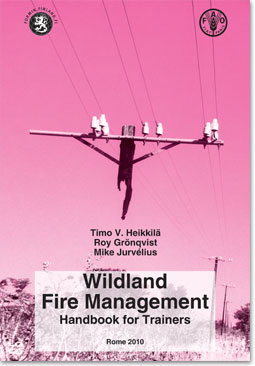Wildland Fire Management
-----------------
19 April 2010, Rome - Fighting wildfires requires the participation of local communities, since most fires stem from human activities, says a new version of FAO's "Wildland Fire Management Handbook for Trainers," co-published today by the UN agency and the Finnish Ministry of Foreign Affairs.
"When local communities benefit from protecting their natural resources they are more likely to be mobilized to prevent fires," said Pieter van Lierop, FAO Forestry Officer. Where people have a direct interest in protecting their natural resources, the number and size of unplanned wildfires started by people are likely to drop significantly.
The handbook highlights that the risk, frequency, intensity and impacts of wildfires can be reduced through more integrated approaches to fire management, including fire detection and suppression but also monitoring, early warning, prevention and preparedness.
"There should be the right balance between activities involving suppressing fires and investing in costly forest-fire equipment on one hand, and establishing effective prevention and awareness-raising among local communities on the other," van Lierop said.
Scale and causes of wildfires
Globally, more than 350 million hectares (ha) are estimated to be affected by vegetation fires eah year — about half or more of this area is burnt in Africa.
An estimated 150 to 250 million ha of tropical forests are affected by wildfire annually.
Between 700 thousand and 1 million ha in the Mediterranean area suffer from vegetation fires every year.
Ninety to 95 percent of all such fires have a human cause.
The expansion of agriculture and other forms of land conversion in developing countries, negligence, the increased use of wildlands for recreation, such as picnics and barbecues, and tourism in both developed and developing countries are among the reasons for the increasing incidence and impacts of wildland fires. Many fires are intentionally set to clear land for agriculture, and often burn much larger areas than was originally intended.
However, simply prohibiting burning is not a practical solution. "People will light fires anyway, even if it is legally banned, in order to clear land or to dispose of rubbish," van Lierop said. "So it is more beneficial to train local communities in fire management and to develop alternative less harmful solutions with them. Burning land at the end of winter, for example, will lower the risk of bigger devastating fires."
Fire: a necessary evil
Fire can be very destructive and at the same time be a very useful land management tool if carefully timed and used. Fire and ecosystems have been linked in many ways for millennia, and that must be recognized for any wildland fire management to be effective, according to FAO. It is important that planned burning in ecosystems takes place to maintain biodiversity, ensure regeneration, and forage production.
For instance, it is known that in Southern Africa, controlled burning of savanna provides edible forage for animals compared to unburnt areas and reduces the fire risk by reducing the accumulation of dry and inedible older grasses. In grassland ecosystems, fire is the primary mode of decomposition, crucial for returning nitrites to the soil and allowing the grasslands to sustain their high productivity.
Successful fire management requires training of local communities to improve their knowledge of fire impacts on food security and rural livelihoods. Also, land-use authorities and managers around the world need to be educated in ecological fire management. Creating special forest fire control units in each country is another important step to monitor and prevent disastrous forest fires.
In Thailand, massive education and training programmes involving foresters and the general public have resulted in a reduction of indiscriminate burning by 30 percent, the publication mentions. "Developing countries should look into such positive practices and put more efforts into community based fire management education and prevention of fires," added van Lierop.
|
Wildland Fire Management Handbook for Trainers By: Heikkilä, T.V., Grönqvist, R. and Jurvelius, M. Rome, 2010 Food and Agriculture Organization of the United Nations, Forest Management Team, Forestry Department Ministry of Foreign Affairs of Finland, Helsinki, Finland |
---------------


